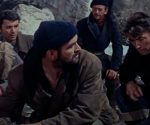Martin Scorsese’s favourite gangster films – full list | Films | Entertainment
The king of the gangster film genre, legendary director Martin Scorsese, also had his heroes. The genius mind behind classics like The Irishman, Goodfellas and Casino compiled his favourites into a list for the Daily Beast back in 2010.
In the article, he comments about the fifteen biggest cinematic inspirations that “had a profound effect” on him and the way he thought about crime and how to portray it on film: “They excited me, provoked me, and in one way or another, they had the ring of truth.”
He disclaims, though, that he stopped listing his references before the 1970s, because “we’re talking about influence here, and I was looking at movies in a different way after I started making my own pictures”.
Although, he concedes and cites Performance, the Godfather saga, Leone’s Once Upon a Time in America, The Long Good Friday, Sexy Beast and John Woo’s Hong Kong films as some recent ones he enjoys.
Here, we have a look at Scorsese’s favourite gangster films, and his opinion on them.
The Public Enemy (1931)
A pre-Code gangster film, The Public Enemy follows Tom Powers, an Irish-American street punk, who rises from petty crime to a ruthless bootlegging kingpin, ultimately facing tragedy and violence in the Prohibition era. Scorsese noted: “The shocking, blunt brutality; the energy of Cagney in his first starring role; the striking use of popular music (the song “I’m Forever Blowing Bubbles”) – this picture led the way for all of us.”
Scarface (1932)
Scarface follows Tony Montana, a Cuban refugee who rises to become a powerful drug lord in Miami’s cocaine scene, only to fall victim to his own ambition and the violence he embraces, in a story of greed and excess. “[Howard] Hawks’ film is so fast, so fluid, so funny, and so excitingly expressionistic. The audacity of it is amazing. It was finished by 1930, but it was so violent that it was held up by the censors”, said Scorsese.
Blood Money (1933)
Another pre-code crime drama, Blood Money is about a corrupt bail bondsman, Bill Bailey, who becomes entangled with a thrill-seeking socialite, Elaine Talbart, and the criminal underworld of Los Angeles.
Scorsese said: “[Director] Rowland Brown, a largely forgotten figure, made three tough, sardonic movies in the early ‘30s, each one very knowledgeable about city politics, corruption, the coziness between cops and criminals. This is my favorite. The ending is unforgettable.”
The Roaring Twenties (1939)
A gangster drama set during the turbulent period between World War I and the Great Depression, The Roaring Twenties follows three men’s experiences in the 1920s, including Prohibition-era violence and the 1929 stock market crash. “In 1939, Raoul Walsh and Mark Hellinger’s classic was seen as a sendoff to the gangster genre, which seemed to have run its course”, said Scorsese. “But it’s more than that. Much more. It plays like a journal of the life of a typical gangster of the period, and it covers so much ground, from the battlefields of France to the beer halls to the nightclubs, the boats that brought in the liquor, the aftermath of Prohibition, the whole rise and fall of ‘20s gangsterdom, that it achieves a very special epic scale – really, it was the template for GoodFellas and Casino. It also has one of the great movie endings.”
Force of Evil (1948)
In this classic noir, lawyer Joe Morse works for a gangster who schemes to control the numbers racket – but his plan is complicated by his older brother Leo, who runs a small-time operation and refuses to participate, leading to tragedy. “John Garfield is the mob lawyer, Thomas Gomez is his brother, a numbers runner who’s loyal to his customers and his employees. The conflict is elemental – money vs. family – and the interactions between the brothers are shattering”, Scorsese explains. “The only gangster picture ever done in blank verse, by Abraham Polonsky. Truthfully, it had as great an impact on me as Citizen Kane or On the Waterfront.”
White Heat (1949)
White Heat stars James Cagney as psychopathic gangster Cody Jarrett, who leads his gang in a series of heists, including a daring escape from prison and a payroll heist at a chemical plant. “Cagney and Walsh bit into this movie about a psychopathic gangster with a mother fixation as if they’d just abandoned a hunger strike. They intentionally pursued the madness of Cagney’s Cody Jarrett, a psychopathic gang leader with a mother complex. The level of ferocity and sustained energy is breathtaking, and it all comes to a head in the scene where Cagney goes berserk in the dining hall… which never fails to surprise me”, commented Scorsese.
Night and the City (1950)
Harry Fabian, a small-time hustler played by Richard Widmark, dreams of a “life of ease and plenty” in post-war London. He then schemes to become a wrestling promoter, ultimately learning the harsh price of his ambition when his plans unravel. According to Scorsese, the film is about “desperation, no holds barred”. He added: “We all loved and admired Richard Widmark from his first appearance in Kiss of Death, but his performance as Harry Fabian marked us forever. As did the rest of this hair-raising picture set in post-war London, the first made by Jules Dassin after he escaped the blacklist.”
Touchez pas au Grisbi (1954)
One of the only two non-English-language films in Scorsese’s list, French gem Touchez Pas Au Grisbi (translated to Don’t Touch the Loot) is a film about an aging gangster, Max, who, after one last heist, tries to retire but is forced back into the underworld when his friend is kidnapped and his loot is demanded as ransom. “Jacques Becker, who had worked as Jean Renoir’s assistant, made this picture with Jean Gabin, about an aging mobster who is forced out of retirement to save his old partner. The style is elegant and understated, the aura of weariness and mortality extremely powerful”, he said.
The Phenix City Story (1955)
1955 film noir The Phenix City Story is based on the real-life murder of Alabama politician Albert Patterson, who was running for Attorney General to clean up the crime-ridden city of Phenix City, and the subsequent events that unfolded. Scorsese praised it as “a completely unsentimental picture by Phil Karlson that closely follows the true story of wholesale corruption, intimidation, racism, and terrifying brutality in the once-notorious town of Phenix City, Alabama – where it was shot on location… in 10 days! Fast, furious, and unflinching.”
Pete Kelly’s Blues (1955)
Crime drama film Pete Kelly’s Blues follows a Kansas City jazz cornetist and his band who are targeted by a mobster in 1927, leading to a tragic outcome after they refuse to comply with his demands. “A beautifully made picture, in glorious color and Scope, directed by and starring Jack Webb as a cornet player in the ‘20s whose professional life is infiltrated and turned inside out by a Kansas City gangster (Edmund O’Brien)”, says Scorsese. “This kind of situation happened over and over again in the big-band years and later during the doo-wop era. It’s also at the center of Love Me or Leave Me, another tough Scope musical made around the same time.”
Murder by Contract (1958)
In Murder by Contract, cold-blooded hitman Claude struggles with his assignment to kill a witness, Billie Williams, who is under heavy police protection, finding the task particularly difficult as he thinks women are harder to kill than men, for they are “unpredictable”. Scorsese’s comments are: “A highly unusual, spare, elemental picture made on a low budget by Irving Lerner – a lesson in moviemaking. It’s about a hired gunman (Vince Edwards), and it’s from his point of view. The scenes where he’s alone in his apartment preparing for a hit were very much on my mind when we made Taxi Driver, and we studied the haunting guitar score and its role in the action when we were working on the music for The Departed with Howard Shore. For me, an inspiration.”
Al Capone (1959)
This biopic chronicles the rise and fall of the notorious gangster, portrayed by Rod Steiger, from a bodyguard to the leader of a criminal empire during the Prohibition era in Chicago, ultimately leading to his downfall. “This sharp, spare low-budget film by Richard Wilson, one of Orson Welles’ closest collaborators, deserves to be better known. Rod Steiger is brilliant as Capone – charming, boorish, brutal, ambitious”, said Scorsese. “There’s not a trace of sentimentality. Wilson also made another striking crime film, Pay or Die, about the Black Hand in Little Italy right after the turn of the century.”
Le Doulos (1962)
In the second French film in this list, recently released gangster Maurice plans a revenge robbery with his friend Silien, but the heist goes wrong, leading to suspicion that Silien may have betrayed him – blurring the lines of loyalty and trust in the Parisian underworld. Scorsese wrote: “The French master Jean-Pierre Melville, a close student of American moviemaking, made a series of genuinely great, extremely elegant, intricate, and lovingly crafted gangster pictures, in which criminals and cops stick to a code of honor like knights in the age of chivalry. This is one of the best, and it might be my personal favorite.”
Mafioso (1962)
In Mafioso, Antonio “Nino” Badalamenti – a good-natured factory supervisor – returns to his native Sicily with his family, where a decades-old oath forces him to fulfill a nightmarish obligation related to his past as a young mafioso. “A transplanted northerner living up north with his wife and family (the great Alberto Sordi) goes home to Sicily, and little by little, gets sucked back into the old loyalties, blood ties, and obligations. It starts as a broad comedy. It gradually becomes darker and darker… and darker, and by the end you’ll find the laughs catching in your throat. One of the best films ever made about Sicily”, commented Scorsese.
Point Blank (1967)
Lee Marvin stars in Point Blank as Walker, a gangster who is betrayed and left for dead by his partner Mal Reese (John Vernon) after a robbery on Alcatraz, leading Walker on a relentless quest for revenge and to recover his stolen money and wife. “This was one of the first movies that really took the storytelling innovations of the French New Wave—the shock cuts, the flash-forwards, the abstraction—and applied them to the crime genre”, commented Scorsese. “Lee Marvin is Walker, the man who may or may not be dreaming, but who is looking for vengeance on his old partner and his former wife. Like Burt Lancaster in the 1948 I Walk Alone, another favorite, he can’t get his money when he comes out of jail and enters a brave new corporate world. John Boorman’s picture re-set the gangster picture on a then-modern wavelength. It gave us a sense of how the genre could pulse with the energy of a new era.”









